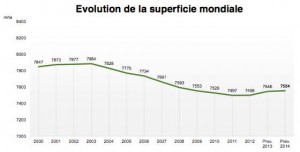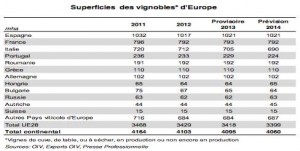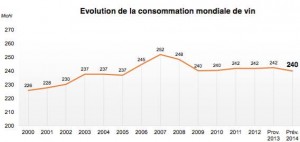China has become the second world’s largest vineyard in the world
China has become the second world’s largest vineyard in the world
The “Middle Kingdom” now has bigger vineyards than France
According to the OIV (International Vine and Wine Organisation) China became in 2014, behind Spain (1,021 million ha), the second vineyard in the world in terms of area with almost 800,000 hectares of vines.

Development of the world vineyard: moving towards a trend reversal?
« Since the end of the grubbing measures in the European Union (EU), plantations in Asia and South America have slightly overcompensated for the reduction in the EU vineyards, as well as the Australian areas under vines. » (OIV)
There was a slight growth in the world vineyard area (7554 mha, +8mha).
World wine production: the year 2014 is at a good average
« Following a record year in 2013 (291 million hectolitres), a good level of global wine production was reached in 2014 (279 million hectolitres).

In Europe, France and Germany recorded huge increases of +11% (46.7 million hectolitres and 9.3 million hectolitres respectively). Meanwhile, Romania, Italy and Spain saw respective declines of 20%, 17% and 9% (4 million hectolitres, 44.7 million hectolitres and 41.6 million hectolitres), after significant harvests in 2013.
Outside Europe, the United States (22.3 million hectolitres) and South Africa (11.3 million hectolitres) maintained good levels of production. Production stabilised in Argentina (15.1 million hectolitres) and saw a slight decrease in Australia (12 million hectolitres). New Zealand’s record production (3.2 million hectolitres) should also be highlighted. The most significant declines were in Chile (-18% with 10.5 million hectolitres) and China (-5% with 11.1 million hectolitres). »
Global wine consumption: a slight drop in 2014

2014 World wine consumption is estimated at 240 mhl, a decrease of 2.4 mhl compared with 2013. The traditional consumer countries resumed their downward trend (or stagnation), to the advantage of new consumer countries both in Europe and in the rest of the world.
With 30.7 mhl, the United States confirmed its position as the biggest global consumer country. France (27.9 mhl) and Italy (20.4 mhl), in keeping with past trends, resumed their decline between 2013 and 2014, by 0.9 mhl and 1.4 mhl respectively. The level of consumption in China is estimated at 15.8 mhl: a reduction of 1.2 mhl compared with 2013.
Source for the statistics: OIV
